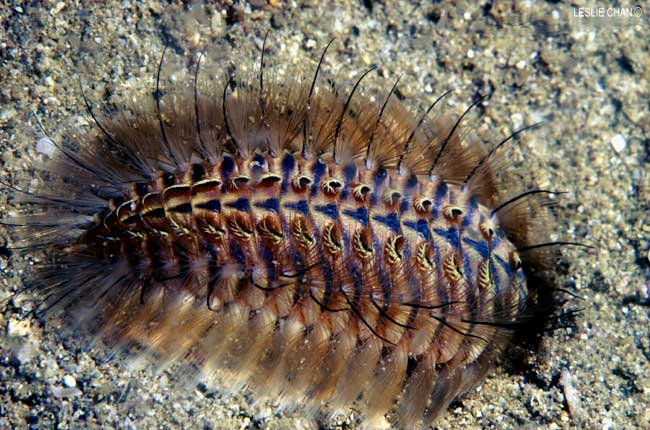
Source of Image
Notes for Chapter 17:
Annelida (Segmented Worms)
Click link to return to Lecture
Schedule
or back to Chapter 16
or ahead to Chapter 18 (under construction)
Chapter 17 Assignment: 356-364, 371-374; RQ-17: 1, 5-6, 8, 12
Introduction: Dividing the Body (Segmentation)
Featured organism: Chloeia sp.
More Links: 1
- 2 - 3
- 4
I. Annelids
(about 15,000 species) – name means "many
little rings"
More
Links
or here
Key Terms: segments, metamerism, metameres, setae, parapodia, spiral cleavage, mosaic (determinate) development, lophotrochozoans (see p. 210; the clade of annelids, molluscs, and various other protostome worms and lophophorates, but not arthropods, nematodes, and other animals with a molted exoskeleton - the ecdysozoans), protostomes = lophotrochozoans + ecdysozoans
II. Body Plan
Key Terms: prostomium, peristomium, eversible proboscis, pygidium, schizocoel, mesenteries, septa, hydrostatic skeleton, nephrostome
III. Polychaeta
Key Terms: parapodium (with notopodium and neuropodium, supported by acicula), radioles, hypoworm
Most diverse are polychaete
annelids – "many setae"
These include all annelids except "clitellate" annelids
Clitellates have a clitellum used in reproduction
Clitellates include earthworms and leeches
(see cladogram on p. 372, we will cover clitellates in lab)
Polychaetes are diverse,
mostly marine, annelids
Get to know these genera and their life style:
Nereis, Eunice viridis, Amphitrite, Chaetopterus, Arenicola, Sabella
Two ways to characterize polychaete diversity:
1) crawlers vs. burrowers vs. tube-builders
Example of crawler: Nereis (Fig. 17-3, 17-7)
crawlers use setae on ventral parapodia (lateral lobes) neuropodia
setae supported by acicula (rods)
paired coeloms in each segment acts as hydrostatic skeleton
coeloms separated by mesentery tissue (Fig. 17.1)
surrounded by longitudinal and circular muscles
dorsal parapodia are used as gills (notopodia)
"head" is made up of prostomium (eyes, brain, sensory palps) and peristomium (jaws, surrounds mouth)
crawlers often have all or the most posterior parapodia of their body become modified for swimming when it is time to reproduce, which they do in great swarms, often very synchronously timed (see Eunice viridis, the palolo worm, Fig. 17-6, which will spawn in American Samoa one week after the October full moon, October 9 in 2001!). Actually, the entire worm is not collected - only the posterior part called an epitoke, which by October has become specialized as a swimming bag of gametes. The epitoke has no head but does have two new eyes added so it is able to swarm directionally towards the moonlight. Towards dawn (if not caught first) the epitoke will literally explode, freeing the eggs or sperm. Native Samoans prefer the female (more blueish) epitokes to males, but eat both, often cooked wrapped in laplap leave along with a mixture of banana, coconut milk, and meat. Epitokes are found in other polychaetes as well, and sometimes the mature worm buds of multiple epitokes at once. The anterior end of the worm will recover to perhaps breed again in the following year. Such reproductive cycles are under hormonal control.
2) Burrowers emphasize hydrostatic
skeleton (see p. 647)
Examples: Amphitrite
(Fig. 17-4), Arenicola
(17-5), earthworm (p. 647)
3) Tube-builders
live in blind tube (a sanitation problem for a bilateral animal)
Usually feed with tentacles (notice which way the food particles move past the
tentacles)
Examples: Sabella
(Fig. 17-10), Serpula,
Phragmatopoma
(honeycomb
tubeworm); Chaetopterus
(Fig. 17-11) also makes
a tube but lives in a u-shaped burrow in
sandy bottoms
Another way to contrast polychaetes - Diversity
of Feeding:
1) macrofeeders (e.g., Nereis feeds on worms)
2) detritus feeders (see Fig. 17-4 a-d)
Examples: Arenicola, Amphitrite
tentacles u-shaped in cross-section
cilia in food groove bring particles to animal
cilia outside of groove move tentacle away
Arenicola is a subsurface deposit feeder
Amphitrite is a surface deposit feeder
3) mucous suspension feeders
Example: Chaetopterus
Chaetopterus lives inside u-shaped burrow
muscular contractions drive water through tube
strains plankton with mucous filter
4) tentaculate suspension feeders
Example: Sabella
Carefully study Fig. 17-10
note how plankton is drawn up through tentacles
mucus helps trap particles
cilia in food grooves move particles to mouth
5) symbiotic association with microbial organisms
Example: Riftia
live near hydrothermal vents in deep sea
harbor sulfur-oxidizing microbes inside body
worm lacks a gut entirely (depends on microbial chemosynthesis)
these worms are called pogonophorans
these annelids were placed in separate phylum until recently
microbes live in special structure called a trophosome
IV. Oligochaeta (covered in lab)
V. Hirudinea: Leeches (covered in lab)
Key Terms: clitellum (synapomorphy of Clitellata = oligochaetes + leeches; see Fig. 17-23)
VI. Evolutionary Significance of Metamerism
Note: Clark's 1964 scenario for explaining the
coelom and segmentation related to burrowing efficiency is very popular but
has major problems and has been increasingly criticized in recent years. One
problem is the distribution of burrowing in annelids is too phylogenetically
restricted to be a condition that was likely present in the common ancestor.
For example, it is likely that the common ancestor of annelids was small, and
small polychaetes often lack the partitioning of the segmented body that is
used as a hydrostatic skeleton in annelids such as the terrestrial earthworms.
It appears more likely that the coelom first evolved in annelids as a respiratory
structure or for some other function and was later modified to be used also
for a hydrostatic skeleton in some larger burrowing annelids.
VII. Phylogeny and Adaptive Radiation
Click link to return to Lecture
Schedule
or back to Chapter 16
or ahead to Chapter 18 (under construction)
This page created 10/5/01 © D.J. Eernisse, Last Modified 10/7/01, Links Last Completely Checked 10/5/01